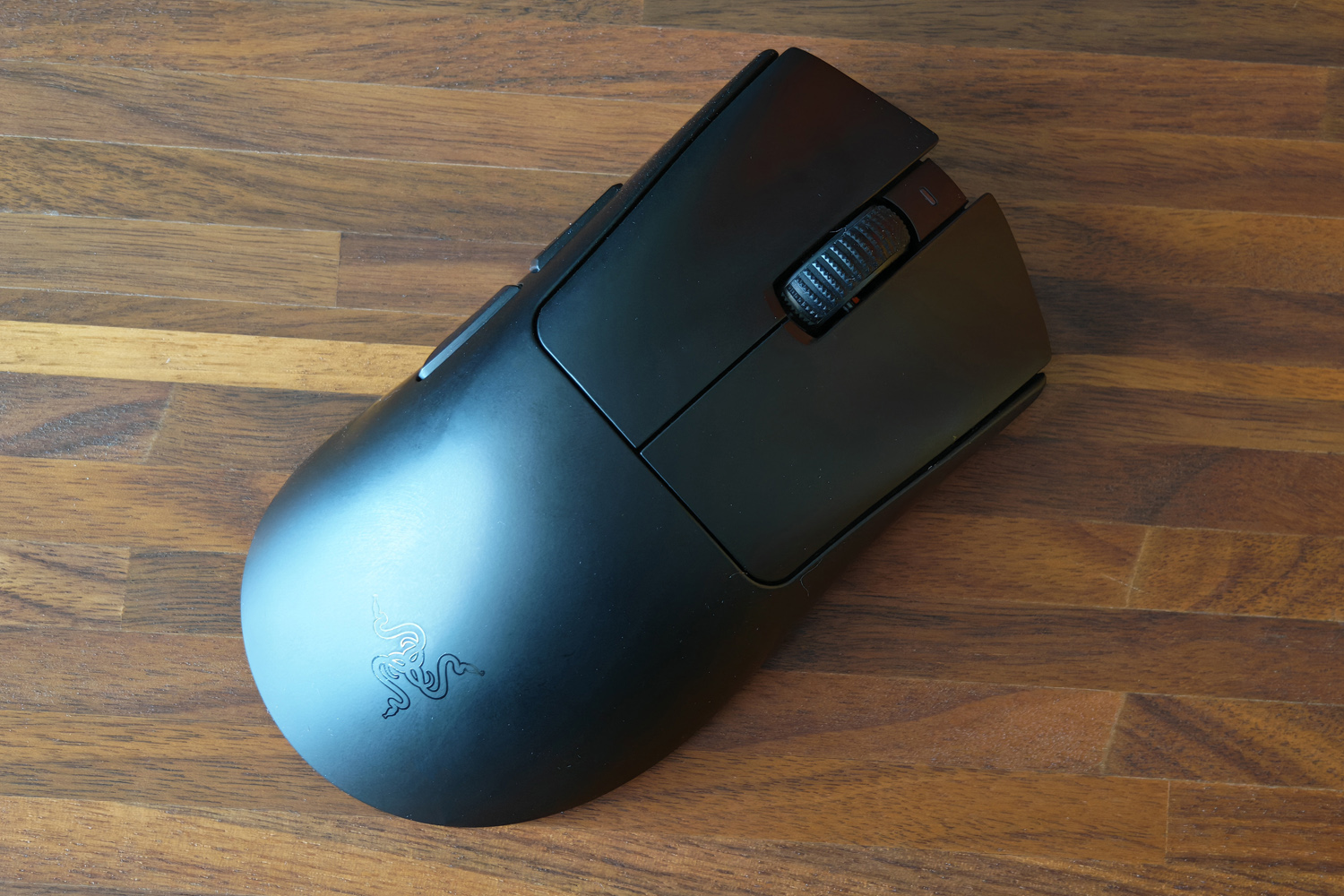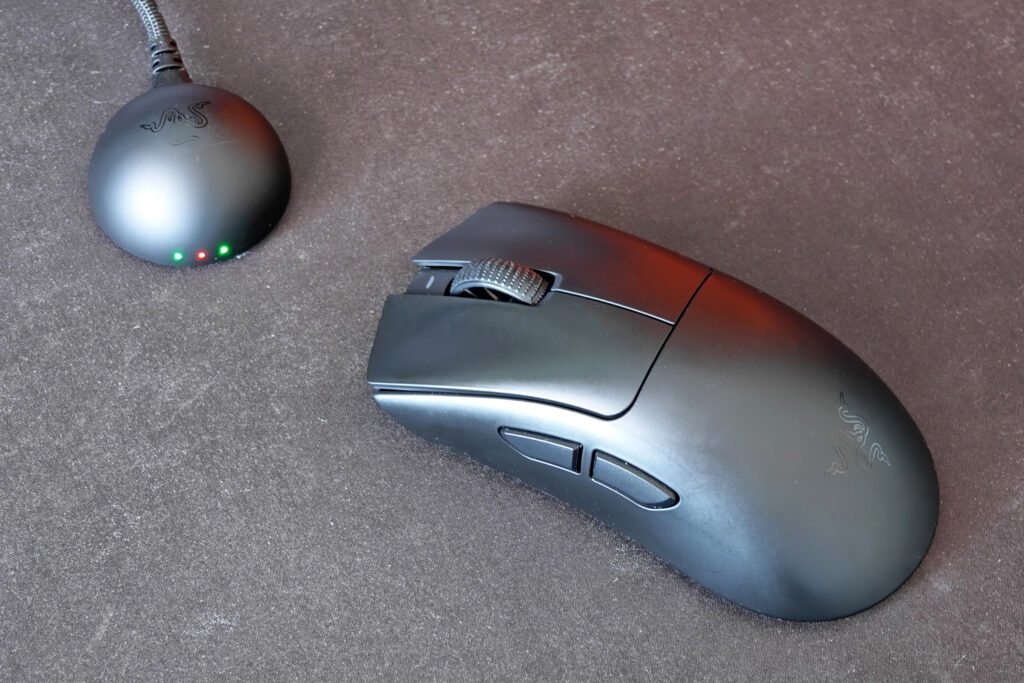Hunting for a gaming mouse that perfectly matches your grip can feel like a wild goose chase, so when one finally fits you tend to stick with it. It’s why I literally played the original Razer Deathadder to destruction during my University years, and struggled to find an alternative that felt as comfortable to pair with my gaming laptop ever since. The esports-grade rodent has gone through multiple iterations since then, and this latest might be the best of the bunch.
Razer has updated the fan favourite with all-new internals, a longer lasting battery, and uprated wireless tech that promises speed and stability in equal measure. The Deathadder V4 Pro is also lighter and more wear-resistant, without altering that all-important shape. At $170/£170 it’s a serious investment, sure – but the across-the-board improvements and unbeatable ergonomics could rocket it to the top of your PC hardware wish list.
Design & build: similar but different

The Deathadder has been honed over multiple generations now, so it’s no surprise that Razer kept the ergonomic shape largely unchanged for the V4 Pro. Owners of the old ones – myself included – are vocal about how they feel moulded to their grip in ways other gaming mice simply can’t match, and changing that would’ve been sacrilege.
That’s not to say things haven’t been tweaked here and there, though. The body is now made from 90% post-consumer recycled plastic, with stiffer sidewalls to help boost rigidity. Despite the heavier materials, Razer has re-engineered the internals to bring the overall weight down to just 56g. That’s 7g less than the Deathadder V3 Pro, and a gram less than Logitech’s G Pro X Superlight 2 DEX. Factor in the larger feet on the underside and this mouse simply glides across desk.
I’m also a big fan of how the two side buttons have been further separated from the previous-gen model, to help cut down on misclicks. It definitely proved effective in my testing, with no accidentally lobbed grenades when I meant to use a healing item in Cyberpunk 2077.
You can pick one up in black or white; sadly Razer isn’t letting normies get their hands on the camouflage pattern seen when Counter-Strike 2 player NiKo used a V4 Pro prototype at the PGL Bucharest 2025 major event earlier this year.
Features & battery life: speed demon
Most of the big changes are underneath, with new Hyperspeed Wireless Gen-2 connectivity taking pride of place. At an 8000Hz maximum polling rate, Razer reckons the Deathadder V4 Pro has an average latency of 0.291ms – a 60% improvement from the previous-gen Deathadder, and more than twice as fast as the quickest competition at the same setting.
The bundled dongle then replies to the mouse just as quickly, rather than just a few times per millisecond, for a reliable connection. There was no point during testing I could get it to falter, with consistent movement at all times. The dongle has a spherical design now, along with re-engineered antennae, for a more consistent signal no matter where you place it on your desk. 8000Hz gaming does need it to be within 30cm of the mouse and with line of sight, which is something to think about if you’re going for an ultra-minimal desktop look. But otherwise it’s as good as being wired directly to your PC.
I’m a big fan of the status LEDs on the dongle that show your connection status, battery life and polling rate; you can customise ’em in Razer’s Synapse software if you want the lights to mean something different. The way the mouse is smart enough to drop back to 1000Hz when you’re not gaming is neat, too; it means battery life doesn’t take an unnecessary hit while you’re staring at spreadsheets or answering work emails.
8000Hz polling is demanding, sapping the battery in about 22 hours. It’ll be overkill for gamers that aren’t pulling a pay check from playing, though, and at a more sensible 1000Hz the Deathadder V4 Pro has fantastic staying power. Razer rates it for 150 hours, or 55 more than a Logitech G Pro X Superlight 2. I charged my review unit fully after finishing 8000Hz testing, and in the two weeks since it’s not needed another trip to the USB-C cable.
You can play wired if you want, of course. The only thing missing is Bluetooth, but that kinda goes against the whole esports ethos. Frequent travellers should probably check out the Cobra Pro instead.
Performance: everything just clicks
The Deathadder V4 Pro has gone all-in on optical, with the mouse sensor, switches and even the scroll wheel getting in on the action for the first time in a Razer esports mouse. As nothing is physically touching the wheel anymore, it should last a heck of a lot longer than a mechanical one, and means ghost scrolling or reverse inputs aren’t an issue. With a fluid but firm ratcheting motion, I also got fantastic consistency and accuracy from scrolling inputs.
New 4th-gen optical mouse switches have reduced the actuation force – or how hard to have to press to trigger an input – by 12% compared to the outgoing model, while keeping the oh-so-satisfying click feel. Each one is rated for a whopping 100 million click lifecycle (I’m not even 0.1% of the way to testing that theory) and I simply can’t fault how well they register my inputs.
Neither would matter if the sensor wasn’t much cop, but Razer’s second-gen Focus Pro 45K Optical Sensor is a beauty. Sensitive all the way up to a ridiculous 45,000 DPI, able to track acceleration at up to 85G, and consistent tracking as fast as 900 inches per second, it’s almost infallible when it comes to translating your hand motion into in-game motion. I had no issues with keeping my cursor locked on demon heads while smashing through Doom: the Dark Ages.
There’s a level of granular adjustment here that’ll please even the most demanding of players. Head into Razer synapse and you can tweak the sensitivity down to 1dpi increments. The DPI switch being on the bottom of the mouse isn’t ideal for swapping sensitivity mid-game (unless you have a Razer keyboard with Hyperswitch macros) but dynamic sensitivity can help. It takes some getting used to, but means fast sweeping motions still spin you a full 180-degrees in first person shooters, while at the same time smaller movements stay precise.
I’ve also been experimenting with the mouse rotation setting, which adjusts how the sensor detects orientation for perfect horizontal swipes even if you hold the mouse at an angle. My typical grip angle isn’t that extreme (-1.8 degrees according to Razer’s testing tool) but after forcing myself to play with the Deathadder seriously rotated, it makes a huge difference.
Razer Deathadder V4 Pro verdict
The last Deathadder was already an esports superstar – its position on the prosettings usage leaderboard has been unshakeable – but this new one is somehow even more refined. It’s impressively light, has herculean staying power, and gaming performance that’s simply superb. It seamlessly fits my hand in a way few rivals have ever managed.
I like that it doesn’t overdose on RGB, and five buttons are all I really need. No Bluetooth isn’t a deal-breaker either, given it helps keep the weight so low.
If you feel otherwise, demand a left-handed rodent, or prefer a smaller size, I can understand why you might look elsewhere. But for everyone else, this is probably all the gaming mouse you could ever need.
Read the full article here
